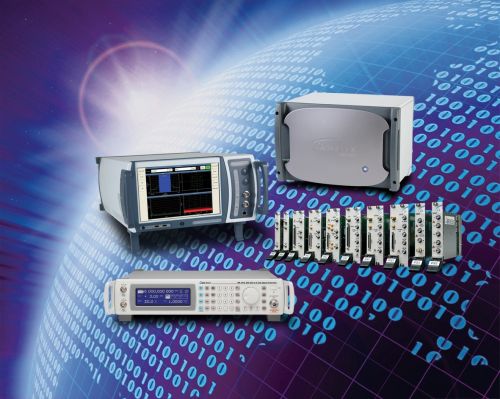LTE测试:你需要知道的那些事
imize data throughput, both under normal and extreme conditions of temperature and power supply voltage. Power consumption, thermal characteristics, electromagnetic compatibility (EMC), emissions, and susceptibility also all need to be measured under full load conditions. Generally, this will involve using 2x2 downlink multiple-input multiple-output (MIMO).
The ability to seamlessly hand over between cells while minimizing the interruption to data throughput needs to be assessed, as does the ability to hand over between different radio access technologies while maintaining the data connection. Compact, flexible, and modular instruments are already available from multiple vendors. For example, Aeroflex’s LTE test products support all the features necessary to characterize the performance of LTE devices (Fig. 2).

Figure 2- Aeroflex’s range of LTE test products includes signal generators such as the 3410 series, with extended bandwidth to suit the new OFDMA radio link, the versatile PXI modular instruments, the TM500 test mobile for eNB and infrastructure testing, and the 7100 LTE Digital Radio Test Set for UE testing.
Although the LTE physical layer uses a cyclic prefix to add resistance to multipath effects, it needs to be tested to ensure correct operation. Leaving this testing until the field trial stage adds risk to the development. Fortunately, test equipment suppliers provide facilities for simulating real-world signal conditions in the lab, with built-in fading simulators and noise generators.
An important performance parameter of an LTE device will be its ability to achieve and maintain synchronization with the downlink signal. The LTE OFDMA scheme uses subcarriers spaced at 15 kHz intervals. The receiver must stay precisely tuned to the subcarriers even under the effect of Doppler shift. Lack of synchronization results in inter-subcarrier interference, reducing SNR. To characterize the behavior of the device, the ability to simulate Doppler shift in the lab is again essential.
Conclusion
The next generation of mobile devices will need to provide a mobile broadband experience that matches the hopes and expectations of the network operators. It will be necessary to test new LTE devices using a layer-by-layer approach, building up to an end-to-end test scenario that uses real-world signal conditions. Ensuring that performance is maintained throughout the cell will be the most difficult challenge, especially as the number of users in the cell grows-and with it the signal noise level.
The thorough and efficient testing of LTE devices requires comprehensive test coverage: RF, protocol and system-level. Test equipment vendors are providing this capability with both new and upgraded instruments, test sets, and systems already available.
Achieving high data throughput and low latency in the most efficient manner possible (in terms of both power consumption and RF spectrum usage) is the main aim of introducing LTE technology. Only through careful testing in the development and deployment stages will this goal be achieved.
References
1. Global Certification Forum www.globacertificationforum.org
2. PTCRB www.ptcrb.com
Biography

Phil Medd, Product Manager, Aeroflex Test Solutions
Phil Medd is a product manager for Aeroflex Test Solutions, based in Stevenage, UK, supporting the 3GPP mobile test products. Medd graduated from Nottingham University in 1977 with a degree in electrical and electronic engineering. Since then, Medd has worked in the test-equipment industry, starting with electronic sys
- AT4为艾法斯拓展WiMAX与协议分析市场(03-28)
- Aeroflex 3500便携式射频测试仪新增VSWR测试功能 (03-28)
- Aeroflex推出C.S 004 4-A测试套件(05-24)
- Aeroflex在其3000 Series产品中加入嵌入式PXI系统控制器(01-01)
- Aeroflex 5800系列推出数字功能,支持混合信号测试(03-10)
- Aeroflex新增的LTE TDD测试套件扩展其PXI 3000系列模块化仪器功能(03-01)
